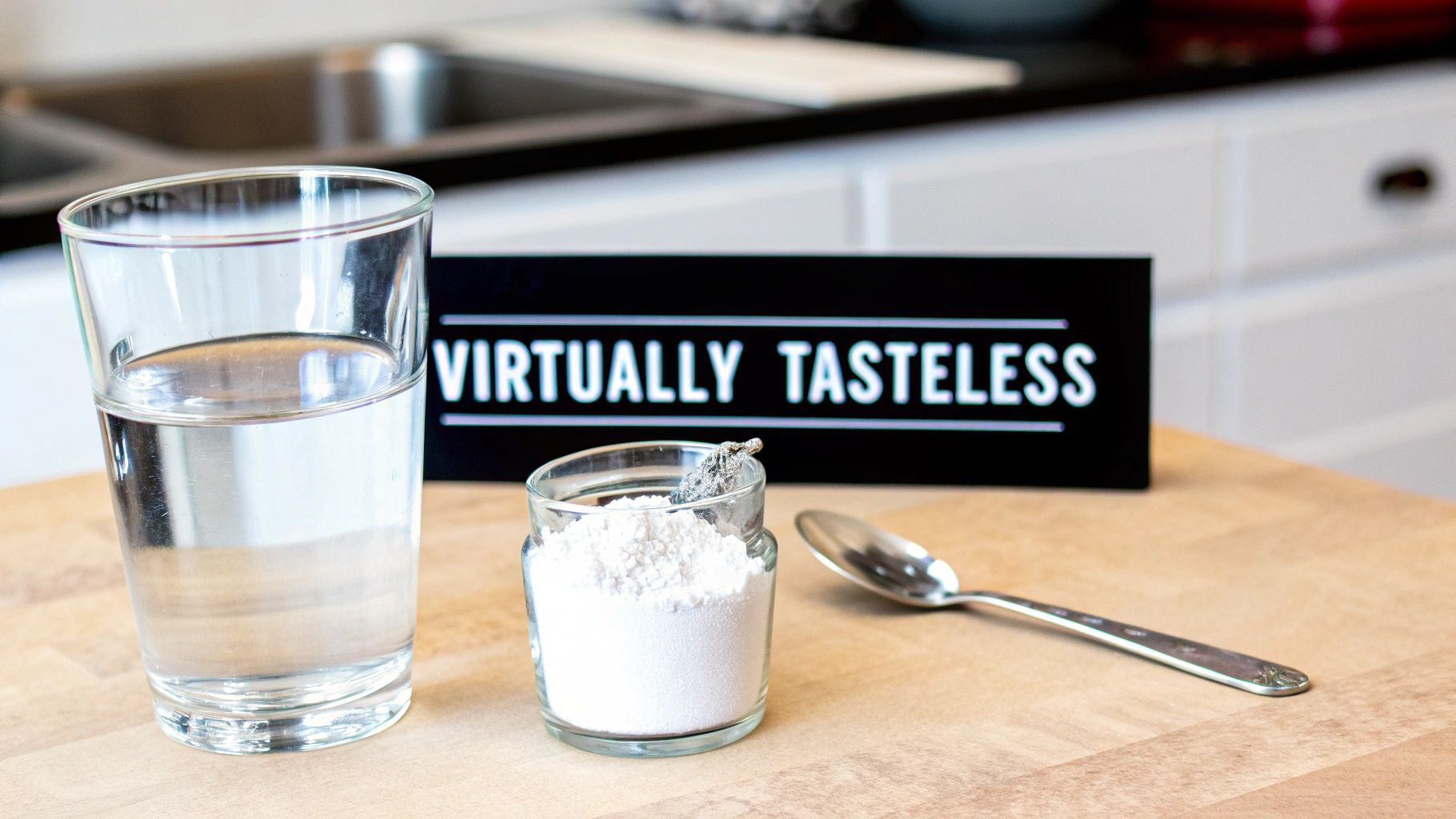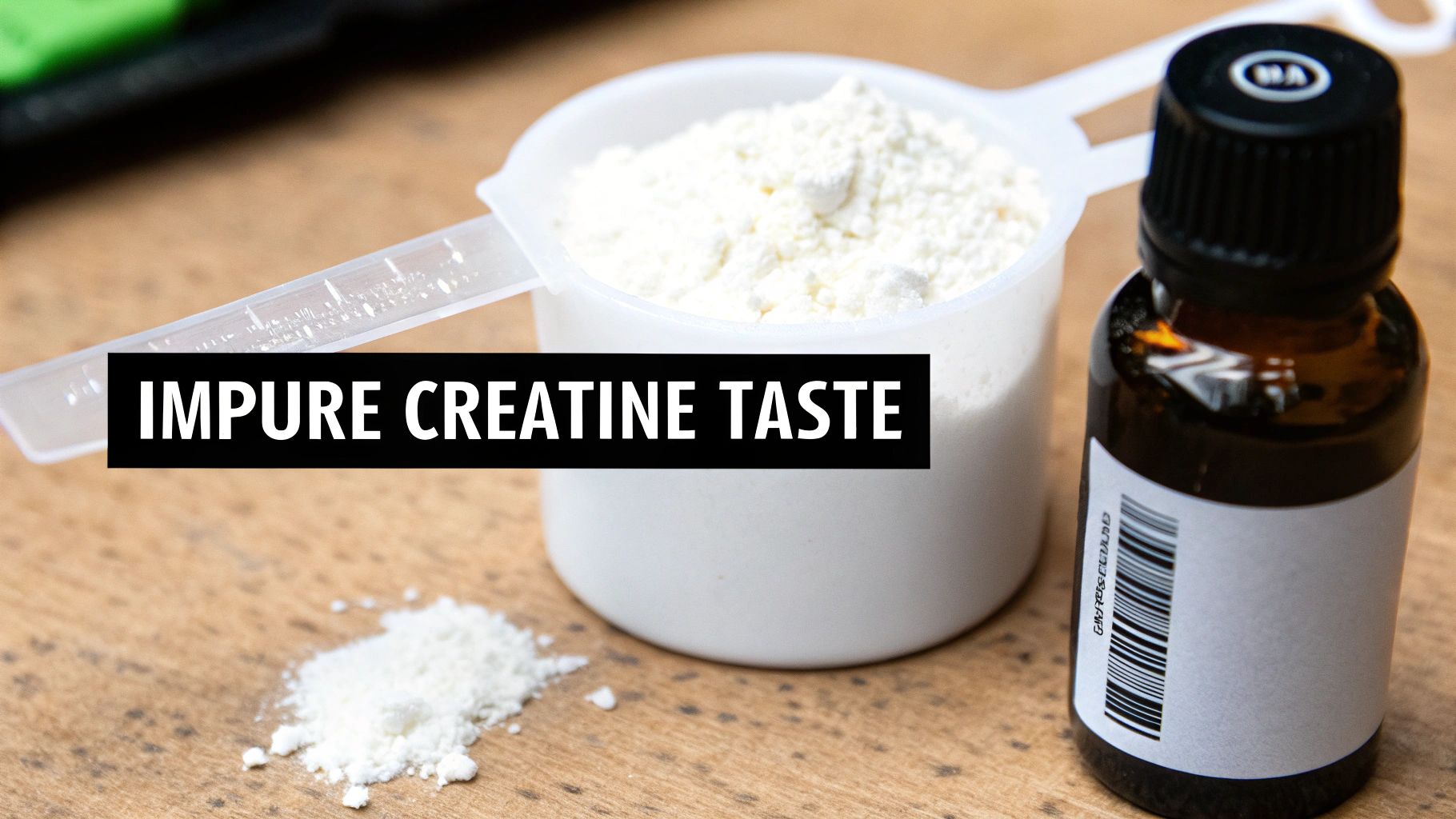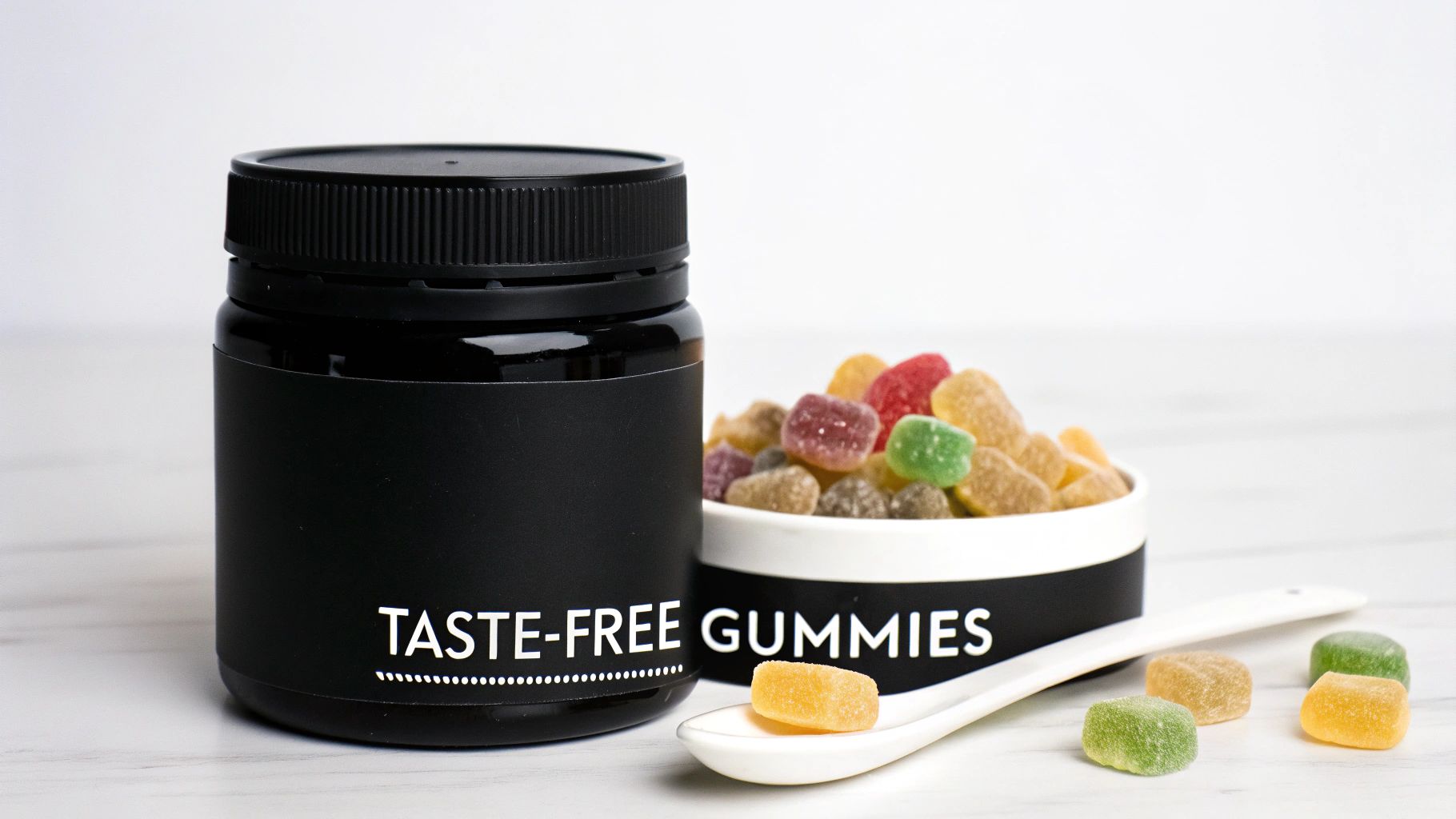
Does Creatine Have a Taste? The Surprising Answer
Share
Ever wondered what creatine is supposed to taste like? The honest answer is... nothing at all. High-quality, pure creatine monohydrate is virtually tasteless and odorless.
If you've ever choked down a creatine powder that was bitter, gritty, or had a weird chemical tang, that wasn't the creatine you were tasting. It was the impurities and manufacturing leftovers that didn't get filtered out.
Unpacking the Flavor Profile of Pure Creatine
Think of it like perfectly filtered water—when it's pure, it just tastes clean. The whole point of a premium supplement is to give you creatine and nothing else. But the reality is, not all powders on the shelf are made to the same standard. The real difference between a top-tier product and a cheap one often boils down to how well it's been refined.
Leftover by-products from the manufacturing process can introduce a slightly bitter or metallic taste. While most people find pure creatine monohydrate completely neutral, studies suggest that about 15-20% of us are sensitive enough to pick up on this faint bitterness, especially when it's mixed with just plain water.
Want to dive deeper into how production impacts quality? Check out our article on the differences between monohydrate and micronized creatine.
A premium creatine should disappear into your drink without a gritty texture or a noticeable aftertaste. If your "unflavored" powder tastes strongly of chemicals, that’s a major red flag for poor quality control.
How to Spot High-Quality Creatine
You can usually tell if you've got a good product just by paying attention to your senses. A pure creatine powder will be very fine, mix into liquid without a fight, and won't hit you with a chemical smell when you open the tub.

When you're trying to figure out if your creatine is top-notch or bottom-shelf, look for these tell-tale signs.
Pure vs. Impure Creatine Taste Profile
| Characteristic | High-Quality (Pure) Creatine | Lower-Quality (Impure) Creatine |
|---|---|---|
| Taste | Neutral, nearly tasteless | Bitter, metallic, or chemical aftertaste |
| Smell | Odorless | Faint chemical or sour smell |
| Mixability | Dissolves easily, minimal grit | Clumps, gritty, settles quickly |
At the end of the day, a truly tasteless experience is the best sign you're getting a pure and effective supplement. It means the manufacturer took the time and care to filter out all the junk, leaving you with nothing but the good stuff.
Why Some "Unflavored" Creatine Tastes So Bad
If pure creatine is supposed to be tasteless, why does that tub of unflavored powder you bought have such a weird chemical bite to it? The short answer is that not all creatine is created equal. The weird taste you're picking up often comes from cutting corners during the manufacturing process, leaving behind unwanted extras.
This is exactly why so many people ask, "does creatine have a taste?" They've had a bad experience with a low-quality product and assume that’s just how it is.

It helps to think of it like brewing coffee. The quality of your beans and your brewing method make all the difference between a smooth, rich cup and a bitter, acidic mess. Creatine production is a chemical process that should result in pure creatine monohydrate, but if the process is sloppy, leftover compounds get into the final product.
Those impurities are almost always the culprits behind that unpleasant taste.
The Science Behind Bad-Tasting Creatine
When creatine is synthesized, the process can leave behind trace amounts of byproducts if the filtration and purification steps are rushed. Some of these unwelcome leftovers include:
- Dicyandiamide (DCD): An ingredient from the early stages of production that leaves a distinct chemical taste if not completely filtered out.
- Creatinine: A waste product that can form during the reaction, adding a slightly bitter or "off" flavor.
- Dihydrotriazine: Another potential impurity that can mess with both the taste and smell of the powder.
The presence of these compounds is a direct reflection of the product's purity. A premium creatine will go through rigorous testing methods like High-Performance Liquid Chromatography (HPLC) to ensure these impurities are virtually eliminated, guaranteeing a neutral taste.
Beyond the chemistry, the physical texture of the powder plays a huge part in how you perceive its taste. A cheaply made creatine often has larger, uneven particles that just don't dissolve well. This gives you that gritty, sandy texture that sinks straight to the bottom of your shaker cup.
That awful mouthfeel makes any subtle off-flavors seem ten times worse, turning your daily supplement routine into a chore you dread. When the powder clumps up instead of dissolving, you’re not just dealing with grit; you're getting a concentrated blast of bitterness with every sip. This is why a smooth, easily dissolved powder is just as critical as chemical purity for a truly tasteless experience.
The Rise of Flavored Creatine
Let's be honest: for a long time, taking creatine felt like a chore. The gritty texture and vaguely bitter taste of unflavored powders were just something you had to put up with. The supplement industry quickly realized that if they wanted creatine to go mainstream, they had to fix the taste problem.
So, they got to work. The solution? Flavored creatine. This wasn't just about dumping some sugar in to mask the bitterness. Brands started getting creative, using everything from sucralose and stevia to real fruit powders to turn a functional supplement into something you'd actually look forward to drinking. The whole idea was to make it as easy and enjoyable as sipping on your favorite sports drink.
No Longer Just for Hardcore Lifters
This focus on taste completely changed the game. Suddenly, creatine wasn't just for bodybuilders and powerlifters who would choke down anything for an edge. It became accessible to weekend warriors, runners, and anyone just trying to stay active and healthy—people who simply won't stick with a supplement that tastes bad.
The numbers tell the story. Back in 2015, only about 30% of creatine products on the market were flavored. Fast forward to 2025, and that number has exploded to over 75%. This shift brought in a much wider audience, with women now making up nearly 40% of creatine consumers, a huge jump from just 15% in 2018. We dive deeper into this trend in our guide to the best flavored creatine options.
This change reflects a simple truth we see everywhere: the user experience matters just as much as the product's function. If something is a pain to use, people will just find a better way.
This push from consumers for a better-tasting product has fueled a ton of innovation. Flavored options take the guesswork out of the equation, giving you a consistent and tasty experience every single time. For most people, that improved taste is the secret ingredient to staying on track with their supplement routine and actually hitting their fitness goals.
Choosing Between Unflavored and Flavored Options
When you're standing in front of the supplement shelf, the choice between unflavored and flavored creatine can seem complicated, but it really comes down to your personal routine and what you enjoy. There's no right or wrong answer here; the best creatine is simply the one you'll actually take day in and day out.
The Purist’s Pick: Unflavored Creatine
Think of unflavored creatine as your go-to "blank canvas" supplement. Its biggest strength is its sheer versatility. You can stir it into your morning coffee, dump it into a post-workout protein shake, or blend it into a fruit smoothie without messing with the flavor you already love.
This makes it perfect if you've already dialed in your supplement stack and don't want to introduce a clashing taste. Plus, it’s usually free of any additives like sugars, artificial sweeteners, or dyes, which is a huge win if you're keeping a close eye on those ingredients. And because it's simpler to make, unflavored creatine tends to be a little easier on your wallet.
The Convenience King: Flavored Creatine
On the flip side, flavored creatine is all about making your life easier and your supplement routine tastier. If you’re someone who just wants to mix creatine with plain water, a fruit punch or blue raspberry option turns a chore into a genuinely enjoyable drink.
Let's be honest, a good flavor can be a great motivator. Knowing you have a delicious drink waiting for you after a tough workout might be the little nudge you need to stay on track. It’s a simple, no-fuss solution that completely sidesteps that subtle bitterness some people pick up from unflavored powders.

This visual breaks it down perfectly. Unflavored creatine is built to be a team player, mixing seamlessly with other drinks. Flavored creatine, however, is the star of the show, designed to be enjoyed all on its own.
To make the decision even clearer, here’s a quick head-to-head comparison:
Unflavored vs. Flavored Creatine Comparison
| Factor | Unflavored Creatine | Flavored Creatine |
|---|---|---|
| Taste Profile | Neutral to slightly bitter; designed to be masked. | Pleasant, often fruity flavors that make it enjoyable with water. |
| Mixing Flexibility | High. Can be added to protein shakes, coffee, juice, etc. | Low. Flavors can clash with other drinks. |
| Convenience | Requires another liquid or food to mix with. | High. Just add water for a tasty, ready-to-go drink. |
| Ingredients | Typically pure creatine monohydrate with no additives. | Contains sweeteners, flavorings, and sometimes colorants. |
| Cost | Generally more cost-effective per serving. | Can be slightly more expensive due to added ingredients. |
Ultimately, choosing comes down to what you prioritize in your daily routine.
Your decision depends on what you value most: the purity and flexibility of unflavored creatine or the superior taste and convenience of a flavored product.
This same thought process applies to other supplements, too. When it comes to finding the best protein powders, you’ll face a similar choice between flavor, ingredients, and how it fits into your lifestyle. The best approach is to pick the option that aligns with your health goals, budget, and daily habits.
How Creatine Gummies Sidestep the Taste Issue
What if you could just skip the whole taste conversation altogether? Instead of wrestling with the slight bitterness of unflavored creatine or the artificial sweeteners in flavored powders, there’s a much simpler way to get your daily dose. Creatine gummies completely reframe the experience, making the taste a total non-issue.
This format delivers a precise, effective serving of creatine monohydrate without any of the old hassles—no mixing, no shaking, and definitely no mess. The creatine is cleverly encapsulated inside a tasty, chewable gummy, which means you never have to deal with that chemical-like aftertaste or gritty texture again. It’s the perfect grab-and-go solution for anyone with a busy lifestyle.

The Next Step in Supplement Simplicity
Let's be honest, gummies solve the main problems that come with creatine powders. You don't have to worry about clumping, and that faint bitterness from unflavored creatine is a thing of the past.
By embedding the creatine into a gummy, the question of "does creatine have a taste?" becomes totally irrelevant. The experience is just... pleasant. That consistency makes it way easier to stick with your routine and hit your fitness goals without a second thought.
This is a real evolution in how we take creatine, putting convenience and a better user experience first. For anyone who values simplicity and doesn't want to compromise on taste, gummies are a massive leap forward. You get all the proven benefits of creatine in a form that feels more like a treat than a chore. If you're curious, you can dive deeper in our guide to creatine gummies.
The practical benefits here are pretty hard to argue with:
- Zero Mess: Forget about powder spills on the kitchen counter or inside your gym bag.
- Perfect Portions: Every serving is pre-measured, taking all the guesswork out of the equation.
- Unbeatable Convenience: No shaker bottle, no water, no stirring needed. Just chew and you're done.
Common Questions About Creatine and Taste
So, we've established that the whole "does creatine have a taste" question isn't a simple yes or no. To clear up any confusion you might still have, let's dive into the questions people ask most often when trying to nail down their creatine routine.
Think of this as a quick-fire round of practical answers to help you pick the right product with confidence.
Can I Mix Unflavored Creatine with Just Water?
You sure can. In fact, it's the most straightforward way to take it. Just be prepared that mixing it with plain water is where you're most likely to notice any of that faint bitterness we talked about. Honestly, a lot of people don't even notice it.
If you happen to be one of the people who does find it a little off-putting, the solution is simple. Toss the powder into something with a flavor of its own—a protein shake, some fruit juice, or a smoothie will do the trick. The other ingredients will easily overpower any subtle taste from the creatine itself.
Does Micronized Creatine Taste Better?
Not really, but it definitely feels better. The "micronizing" process is all about grinding the creatine crystals into a much finer powder. This has a huge impact on how well it dissolves, cutting down on that gritty, sandy texture you sometimes get with standard creatine.
That improved mixability leads to a much smoother drink, which in turn can make any slight bitterness less obvious. While the potential for an off-taste is the same, the better texture is a game-changer for many.
Key Takeaway: The main advantage of micronized creatine is its superior texture and solubility, not a better taste. It just makes for a much more pleasant experience overall.
Are Sweeteners in Flavored Creatine Unhealthy?
This one really comes down to your personal health goals and what you're comfortable with. Most flavored creatine supplements on the market use sweeteners approved by the FDA, like sucralose, stevia, or monk fruit, which are generally considered safe.
That said, some people simply prefer to avoid artificial or alternative sweeteners altogether. If that's you, your best bet is either a high-purity unflavored creatine or a creatine gummy that uses natural sugars for its flavor.
And if you're thinking beyond just creatine, it's smart to consider how different supplements fit into your overall wellness. For those curious about how various supplements can support gut health, you can find great information on the best supplements for digestive health.
Tired of worrying about taste, texture, and mixing? Smash.com offers the ultimate solution. Our delicious creatine gummies deliver your full 5g dose with zero mess, zero mixing, and a consistently great taste every time. Find your favorite flavor and simplify your supplement routine today.